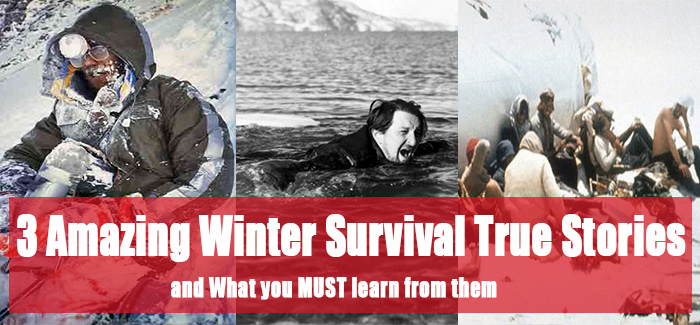1. Alpine Plane Crash: “I had to eat piece of my friend to survive”
Uruguayan Air Force Flight 571, was a chartered flight carrying 45 people, including a rugby union team, their friends, family and associates, that crashed in the Andes on 13 October 1972. More than a quarter of the passengers died in the crash and several others quickly succumbed to cold and injury. The survivors had little food and no source of heat in the harsh conditions at over 11,800 ft altitude. Faced with starvation and radio news reports that the search for them had been abandoned, the survivors fed on the dead passengers who had been preserved in the snow.
Of the 45 people on the plane, 12 died in the crash or shortly thereafter; another five had died by the next morning, and one more succumbed to injuries on the eighth day.
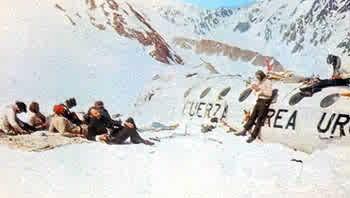
The remaining 27 faced severe difficulties in surviving in the freezing mountains at such a high altitude. Many had suffered injuries from the crash, including broken legs from the aircraft’s seats piling together. The survivors lacked equipment such as cold-weather clothing suitable for the area. They lacked any kind of medical supplies and very little food supplies.
Search parties from three countries looked for the missing plane. Since the plane was white, it blended in with the snow, making it invisible from the sky. The survivors had found a small transistor radio on the plane and heard the news that the search was cancelled on their 11th day on the mountain. Piers Paul Read – one of the survivors – described the moments after this discovery:
The others who had clustered around Roy, upon hearing the news, began to sob and pray, all except Parrado, who looked calmly up the mountains which rose to the west. Nicolich came out of the plane and, seeing their faces, knew what they had heard… [Nicolich] climbed through the hole in the wall of suitcases and rugby shirts, crouched at the mouth of the dim tunnel, and looked at the mournful faces which were turned towards him. ‘Hey boys,’ he shouted, ‘there’s some good news! We just heard on the radio. They’ve called off the search.’ Inside the crowded plane there was silence. As the hopelessness of their predicament enveloped them, they wept. ‘Why the hell is that good news?’ Paez shouted angrily at Nicolich. ‘Because it means,’ [Nicolich] said, ‘that we’re going to get out of here on our own.’ The courage of this one boy prevented a flood of total despair.
The survivors had a small amount of food: a few chocolate bars, assorted snacks and several bottles of wine. During the days following the crash they divided out this food in very small amounts so as not to exhaust their meager supply. Fito Strauch also devised a way to melt snow into water by using metal from the seats and placing snow on it. The snow then melted in the sun and dripped into empty wine bottles. Even with this strict rationing, their food stock dwindled quickly.
The group survived by collectively making a decision to eat flesh from the bodies of their dead comrades. This decision was not taken lightly, as most were classmates or close friends. Nando Parrado comments on this decision:
At high altitude, the body’s caloric needs are astronomical … we were starving in earnest, with no hope of finding food, but our hunger soon grew so voracious that we searched anyway …again and again we scoured the fuselage in search of crumbs and morsels. We tried to eat strips of leather torn from pieces of luggage, though we knew that the chemicals they’d been treated with would do us more harm than good. We ripped open seat cushions hoping to find straw, but found only inedible upholstery foam … Again and again I came to the same conclusion: unless we wanted to eat the clothes we were wearing, there was nothing here but aluminium, plastic, ice, and rock.
Eight of the initial survivors subsequently died when an avalanche cascaded down on them as they slept in the fuselage. For three days they survived in an appallingly confined space since the plane was buried under several feet of snow. Nando Parrado was able to poke a hole in the roof of the fuselage with a metal pole, providing ventilation.
A few of the survivors became insistent that their only way of survival would be to climb over the mountains themselves and search for help. It was decided that a group would be chosen, and then allocated the most rations of food and the warmest of clothes, and spared the daily manual labour around the crash site that was essential for the group’s survival, so that they might build their strength for a journey. They waited nearly seven weeks, to allow for the arrival of summer, and with it higher temperatures.
After several hours of walking east, they unexpectedly found the tail section of the plane, which was still largely intact. Within and surrounding the tail were numerous suitcases that had belonged to the passengers, containing cigarettes, candy and clean clothing. The group decided to camp there that night inside the tail section, and continue east the next morning. However, on the second night of the expedition, which was their first night sleeping outside exposed to the elements, the group nearly froze to death.
After some debate the next morning, they decided that it would be wiser to return.They also realized that unless they found a way to survive the freezing temperature of the nights, a trek was impossible. It was at this point that the idea for a sleeping bag was raised. After the sleeping bag was completed the three men took to the mountain again on 12 December.
Two months after the crash, Parrado, Canessa and Vizintín began their trek up the mountain. Parrado took the lead, and often had to be called to slow down, though the thin oxygen made it difficult for all of them. It was still bitterly cold but the sleeping bag allowed them to live through the nights.
On the third day of the trek, Parrado reached the top of the mountain before the other two. Stretched before him as far as the eye could see were more mountains. In fact, he had just climbed one of the mountains (15,260 ft) which forms the border between Argentina and Chile, meaning that they were still tens of miles from the green valleys of Chile.
Parrado and Canessa sent Vizintín back to the crash site, as they were rapidly running out of rations. Since the return was entirely downhill, it only took him one hour to get back to the fuselage using a makeshift sleigh. Parrado and Canessa hiked for several more days.
First, they were able to reach the narrow valley that Parrado had seen on the top of the mountain, where they found the bed of Rio San Jose. They followed the river and reached the end of the snowline. Gradually, there appeared more and more signs of human presence, first some signs of camping, and finally on the ninth day, some cows. When they rested that evening, they were very tired and Canessa seemed unable to proceed further. As Parrado was gathering wood to build a fire, Canessa noticed what looked like a man on a horse at the other side of the river, and yelled at the near-sighted Parrado to run down to the banks.
The next day, they were saved!
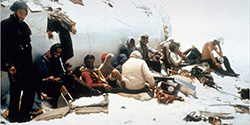
In the morning of the day when the rescue started, those remaining at the crash site heard on their radio that Parrado and Canessa had been successful in finding help and that afternoon, 22 December 1972, two helicopters carrying search and rescue climbers arrived. The expedition (with Parrado on board) was not able to reach the crash site until the afternoon, when it is very difficult to fly in the Andes. The weather was very bad and the two helicopters were able to take only half of the survivors. They departed, leaving the rescue team and remaining survivors at the crash site to once again sleep in the fuselage, until a second expedition with helicopters could arrive the following morning.
The second expedition arrived at daybreak on 23 December and rescued the remaining survivors. All of the survivors were taken to hospitals in Santiago and treated for altitude sickness, dehydration, frostbite, broken bones, scurvy and malnutrition.
The following morning the rescue expedition left Santiago, and after a stop in San Fernando, moved eastwards. Two helicopters had to fly in the fog, but reached a place near Los Maitenes just when Parrado and Canessa were passing on horseback while going to Puente Negro. Nando Parrado was recruited to fly back to the mountain in order to guide the helicopters to the remaining survivors.
2. Jan Baalsrud – 1942
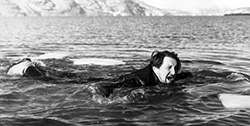 During the Second Word War, Jan Baalsrud joined the Norwegian Company Linge – originally based in Britain. In early 1943, he, three other commandos and the boat crew of eight, all Norwegians, embarked on a dangerous mission to destroy a German air control tower. This mission was compromised when he and his fellow soldiers, seeking a trusted resistance contact, accidentally made contact with an unaligned civilian shopkeeper of the same name as their contact. They were betrayed to the Germans.
During the Second Word War, Jan Baalsrud joined the Norwegian Company Linge – originally based in Britain. In early 1943, he, three other commandos and the boat crew of eight, all Norwegians, embarked on a dangerous mission to destroy a German air control tower. This mission was compromised when he and his fellow soldiers, seeking a trusted resistance contact, accidentally made contact with an unaligned civilian shopkeeper of the same name as their contact. They were betrayed to the Germans.
The morning after their blunder, on March 29, their fishing boat – containing 8 tons of explosives intended to destroy the air control tower – was attacked by a German vessel. The Norwegians scuttled their boat by detonating the 8 tons of explosive using a time delay fuse, and fled in a small boat; however the small boat was promptly sunk by the Nazis.
Jan and others swam ashore in ice cold arctic waters. Jan was the only soldier to evade capture and, soaking wet and missing one sea boot, he escaped up into a snow gully, where he shot and killed the leading German Gestapo officer with his pistol.
He evaded capture for roughly two months, suffering from frostbite and snow blindness. His deteriorating physical condition forced him to rely on the assistance of Norwegian patriots. It was during this time in a wooden hut at Revdal, which he called Hotel Savoy, that Jan was forced to operate his legs with a pocket knife. He believed that he had blood poisoning and that drawing the blood out would help. Not long after that Jan was left on a high plateau on a stretcher in the snow for 27 days due to weather and Nazi patrols in the town of Mandal, his life hanging by a thread.
It was during this time while he lay behind a snow wall built round a rock to shelter him that Jan amputated nine of his toes to stop the spread of gangrene, an action which saved his feet.
He successfully evade the Germans and crossed the border to Sweden where he spent seven months in a Swedish hospital in Boden before he was flown back to Britain. He soon went to Scotland to help train other Norwegian patriots who were going back to Norway to continue the fight against the Germans. After a long struggle to learn to walk properly again without his toes, he eventually got his own way, and was sent to Norway as an agent, where he was still on active service at the time of the war’s end in 1945.
3. Beck Weathers – 1996
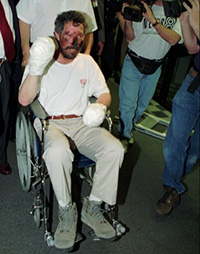
Weathers was one of eight climbers (team) on Mount Everest. However, he soon discovered that he was blinded by the effects of high altitude and snow. On May 10, the day of the summit assault, he wanted to descend to Camp IV because he could barely see, but changed his mind and decided to climb to the top. Weathers, believed that his vision might improve when the sun came out.
Hall – one of the crew members – who was supposed to assist Weathers climbed with some of the crew members to reach the summit and never came down to assist Weathers – and later died high up on the mountain. Weathers eventually began descending with guide Michael Groom, who was short-roping him. When the blizzard struck, Weathers and 10 other men and women became disorientated in the storm, could not find Camp IV, and staggered around for several hours. When there was a break in the storm, Weathers had been so weakened that he and three other climbers were left there so the others could summon help. Anatoli Boukreev, a guide on another expedition led by Scott Fischer, came and rescued several climbers, but during that time, Weathers had stood up and disappeared into the night. The next day, another climber, Stuart Hutchison, later arrived to check on the status of Weathers. Believing that Weathers was near death and would not make it off the mountain alive, Hutchinson left and returned to Camp IV.
Weathers spent the night in an open bivouac in a blizzard with his face and hands exposed. When he awoke, he managed to walk down to Camp IV under his own power. His fellow climbers said that his frozen hand and nose looked and felt as if they were made of porcelain, and they did not expect him to survive. With that assumption, they only tried to make him comfortable until he died, but he survived another freezing night alone in a tent unable to drink, eat, or keep himself covered with the sleeping bags he was provided with. His cries for help could not be heard above the blizzard, and his companions were surprised to find him alive and coherent the following day.
Weathers was later helped to walk on frozen feet to a lower camp, where he was a subject of one of the highest altitude medical evacuations ever performed. Following his escape, he had his right arm amputated halfway between the elbow and wrist. All four fingers and the thumb on his left hand were removed, as well as parts of both feet. His nose was amputated and reconstructed with tissue from his ear and forehead.
You may also like:
 What Happens If You Put Banana Peels In Your Garden?
What Happens If You Put Banana Peels In Your Garden?
How To Make Bark Bread From A Tree That Grows On Almost Every Street In America (Video)
5 Poisonous Plants That Can Be Used As Medicine When SHTF
Livestock Animals You Should Start Raising For The Upcoming Economic Crisis

